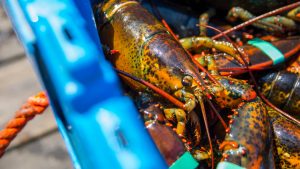New studies attribute warming waters, local differences in oceanography to rise and fall of American lobster populations in the Gulf of Maine
By University of Maine
10/24/2019

Photo Credit: University of Maine
Two new studies published by University of Maine scientists are putting a long-standing survey of the American lobster’s earliest life stages to its most rigorous test yet as an early warning system for trends in New England’s iconic fishery. The studies point to the role of a warming ocean and local differences in oceanography in the rise and fall of lobster populations along the coast from southern New England to Atlantic Canada.
One of the papers, published in the scientific journal “Ecological Applications,” was led by Noah Oppenheim, who completed his research as a UMaine graduate student in 2016, with co-authors Richard Wahle, Damian Brady and Andrew Goode from UMaine’s School of Marine Sciences, and Andrew Pershing from the Gulf of Maine Research Institute. They report that the numbers of young-of-year lobsters populating shallow coastal nursery habitats each year, and temperature, provide a reasonably accurate prediction of trends in the lobster fishery some four to six years later.
Their model predicted regional differences in the recent record-breaking boom over the past decade, and now suggests the Gulf of Maine lobster fishery may be entering a period of decline; in effect a “cresting wave” of lobster abundance that may be heading northward in the region’s changing climate.
Read the original article in Ecological Applications here: https://esajournals.onlinelibrary.wiley.com/doi/full/10.1002/eap.2006